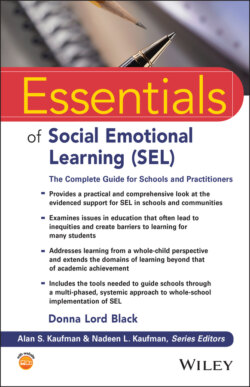Читать книгу Essentials of Social Emotional Learning (SEL) - Donna Lord Black - Страница 31
Rapid Reference 1.4 Three‐Step Process for Developing a Common Vision
ОглавлениеStep 1: Establish a common language. This first step focuses on clarifying the language and terms used to describe SEL and then defining it in terms that are understood by everyone. In this step, members of the stakeholder group identify the many terms used to describe SEL, then discern which of these terms better describe programs, frameworks, skills and competencies, or any other aspect of SEL. Differentiating between the terms should include references to scientific evidence when additional clarification is needed. The group strives to define the terms in clear and precise language, avoiding any jargon or acronyms, so the terms are observable and recognizable to everyone. The group then decides which term or terms will be used by everyone to describe SEL and its skills and competencies, along with any programs, strategies, or interventions that may be used as evidenced support. The group clarifies and articulates the importance of everyone using these terms consistently in all communications between staff, students, parents, and community members. For example, if “SEL” is the term that is chosen, then all stakeholders should agree on a definition of what it is, the skills and competencies on which it will focus (list them), and how it will need to be supported by various programs, interventions, and instructional strategies, all of which will need to be discussed when developing the implementation plan. See “Case Example: Texas Collaborative for Emotional Development in Schools (TxCEDS)” for a practical application of the importance of establishing a common language.
Step 2: Establish a common perspective and understanding of the issues. This second step helps identify the key issues needing to be addressed. In developing a clear understanding of these issues, stakeholders will need to give key consideration to the core values identified by the school or district, and how (or if) they are being reflected in the school’s or district’s vision, mission, policies, procedures, and guidelines. This step involves an open discussion about issues that impact school culture and climate, as well as equitable access to education (e.g., disproportionate practices), cultural considerations, and social and civic responsibility. More detailed information on current challenges in education will be discussed further in Chapter 4.
Step 3: Establish a common, or shared, vision. Once a common perspective of the issues has been clearly defined, understood, and articulated, a vision for SEL can be developed. In this step, key considerations should be given to aligning the school’s or district’s core values with the vision and mission statements. An elaboration on the role of core values will presented in Chapter 9.
Once the three‐step process has been completed successfully, the school or district can move forward with developing a detailed, multistage SEL implementation plan that includes goals, strategies, identified needs or resources, timelines, anticipated outcomes, and methods for monitoring and measuring progress, as well as for adjusting, changing, and improving the plan.
Source: An Introduction to Social‐Emotional Wellness in Texas Schools, A Guide for Schools, Agencies, Organizations, Parents, and Communities. Nancy P. Razo, Ph.D., LSSP. Texas Collaborative for Emotional Development in Schools. © 2017, SPEDTex.
